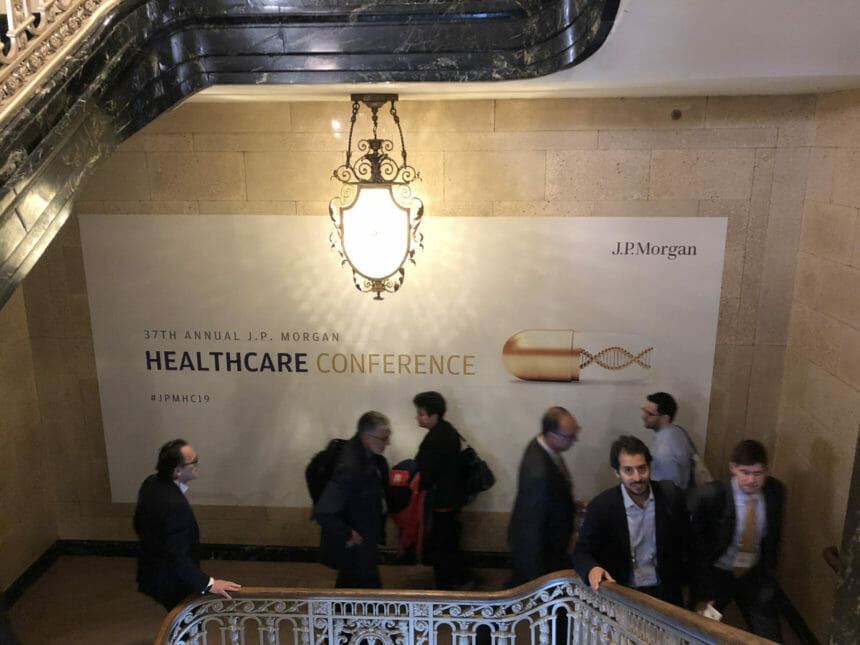Day two of biotech’s largest conference was overcast, a somber palate that matched the outfits of most of the event’s 9,000 attendees. Not among the ranks of gray- and black-suited investors and executives? The day’s keynote speaker, FDA Commissioner Scott Gottlieb. Due to the government shutdown, Gottlieb did not attend the event in-person as planned. Instead, he spoke to a packed room via video conference (at one point, his audio cut out.)
While Gottlieb said he does not believe it is the FDA’s job to directly regulate drug costs, the agency is encouraging competition by making it easier for companies to launch generic drugs. Levers at the FDA’s disposal include removing erroneously awarded patents and releasing a guidance document for companies developing complex generic drugs.
Here are more themes from day two at the JP Morgan Healthcare Conference in San Francisco.
Drug pricing
In session after session, pharma CEOs made sweeping-but-vague pronouncements about making their drugs affordable for patients. However, they provided few realistic solutions.
While innovative payment models such as installment-based plans and efficacy-based reimbursements are being explored by payers, there’s little being done to offset the high cost of medications, particularly innovative treatments.
Case in point: during his session, Bluebird Bio CEO Nick Leschly suggested that the company’s gene therapy for a rare blood disease had an “intrinsic value” of $2.1 million, if you consider the quality and years it adds to patients’ lives. The drug has not been approved.
However, the system simply isn’t ready for one-time, potentially curative therapies, Leschly said. He wasn’t the only pharma chief executive concerned about this. In a conversation about drug prices later on Tuesday, Novartis CEO Vasant Narasimhan argued that a new payment system is needed for innovative treatments, one that measures a drug’s value, cost-effectiveness, and provides insurers with options to make high costs more manageable.

“The industry needs to put forward models, and the payer systems have to adapt to use those models,” he said. Narasimhan conceded that this would require “a significant shift in data and administration systems,” not to mention that U.S. patients regularly change insurers.
Unfortunately, while adopting these payment models could mitigate the up-front sticker shock of innovative, one-time treatments, there’s no guarantee they would actually save the healthcare system money. As the pharma industry focuses on specialty drugs, it could be hurtling towards a tipping point.
See also: Payer-pharma collaboration through value-based contracts is set to accelerate
Digital partnerships and treatments
During her early morning session, GSK CEO Emma Walmsley spotlighted the company’s $300 million stake in 23andMe, which was disclosed in June. GSK will use the consumer genomics company’s genetic data to identify drug targets and find patients for clinical trials.
A few blocks away at Startup Health, JP Morgan’s younger, hipper cousin, digital health was the de facto theme. On a panel on data and healthcare, Sanofi SVP and global head of digital and analytics Heather Bell referenced companies developing digital, clinically validated treatments for diseases, including Omada Health for diabetes and depression and Akili to treat ADHD.
Healthcare has traditionally viewed the tech industry with trepidation — moving fast and breaking things may work fine for a consumer app, but less well for a health device. Yet as the above partnerships and rhetoric indicate, there are health-tech companies that have invested the time and resources to validate their products in a way that meets pharma’s standards.
See also: Top 40 Healthcare Transformer: Heather Bell, Sanofi
Diversity, or more accurately, the lack of it
While the gender breakdown was slightly better than last year, when speakers named “Michael” outnumbered the total number of female CEOs giving company presentations, white men were again the default, both in the halls and on the stage.
Over at Startup Health, where the crowd was noticeably more diverse in age, gender, and ethnicity, Bell said that progress requires being aware of unconscious bias and enforcing explicit targets in terms of diverse hires. Getting the ball rolling is half the battle; diverse teams, she said, tend to hire diversely.
Back at the the Westin lobby for JP Morgan, amid a sea of men in suits and blazers, Excelera CEO Lorrie Carr, one of the few female CEO presenters, said that while more lip-service is being paid to gender diversity, she’s isn’t seeing actual change: “It’s not playing out in practice.”
For highlights from day one, click here.
For highlights from day three, click here.







